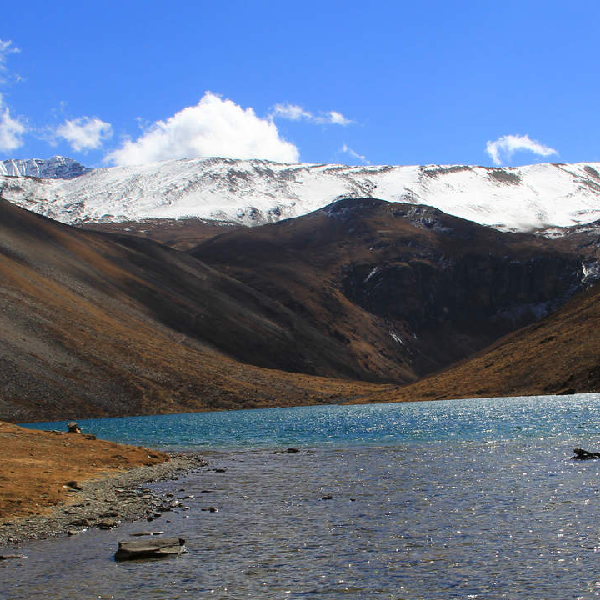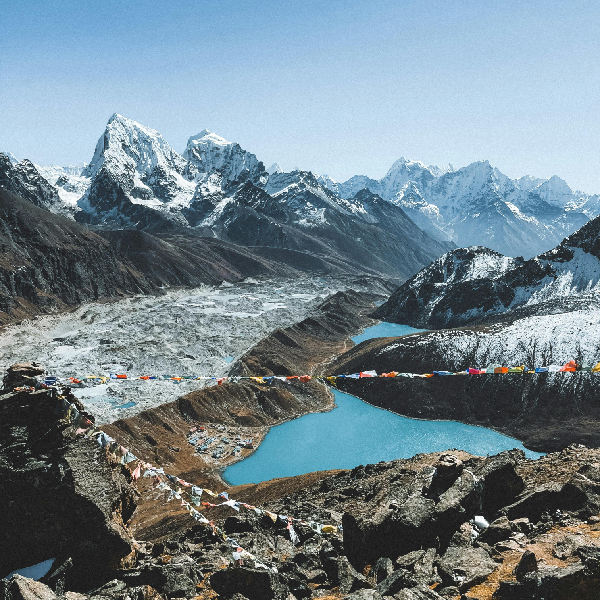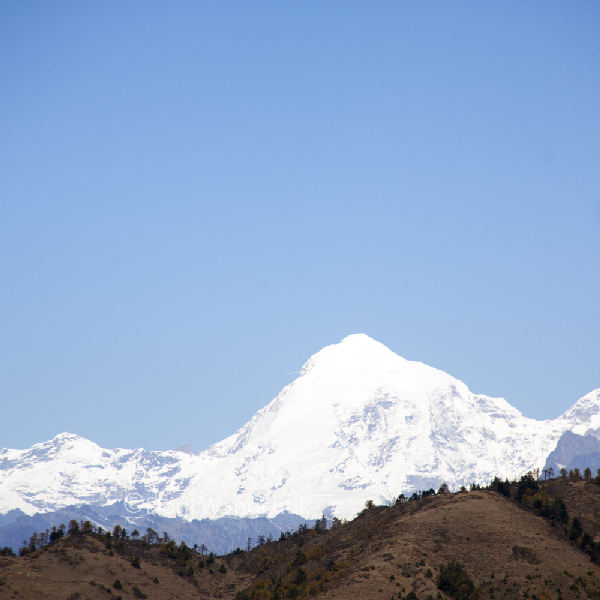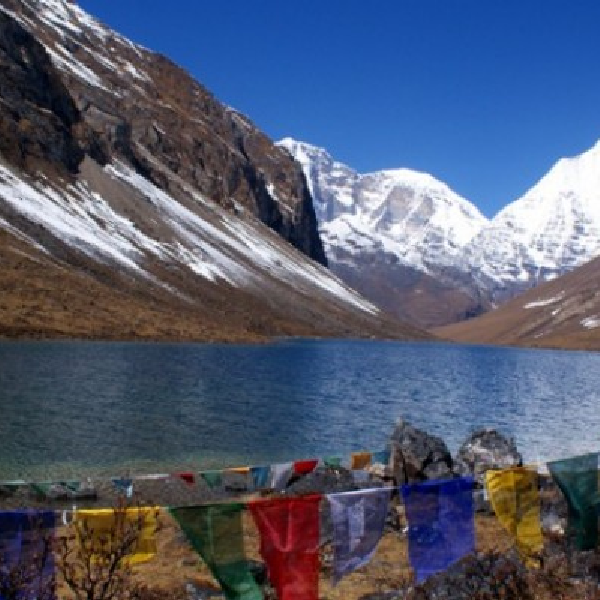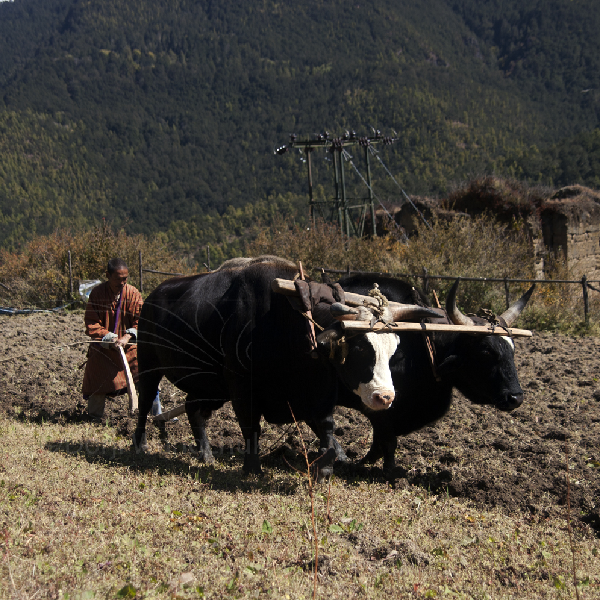Dagala Trek 13 Night 14 Days
Tours Details
- Home
- Bhutan Luxury Tour
- Dagala Trek 13 Night 14 Days
Dagala Trek 13 Night 14 Days
The Dagala Trek unfolds as a captivating high-altitude adventure in Bhutan, immersing trekkers in the pristine wilderness of the Dagala range. Beginning at the picturesque Geynikha Chhorten, the trail winds through alpine meadows adorned with vibrant wildflowers, revealing breathtaking views of serene lakes and snow-capped peaks. The trek spans diverse landscapes, from lush forests to open yak pastures, providing encounters with nomadic yak herders and their traditional way of life. Crossing several mountain passes, including the highest at nearly 4,500 meters, the Dagala Trek offers a challenging yet rewarding journey, allowing explorers to appreciate Bhutan's untouched natural beauty and unique cultural tapestry.
Short Itinerary
|
Days |
Activities |
Accommodation |
Meals |
|
Day 01 |
Arrival in Paro |
Hotel |
[-/L/D] |
|
Day 02 |
Paro – Genekha – Gur (Trek Start) |
Camping |
[B/L/D] |
|
Day 03 |
Gur – Labatama |
Camping |
[B/L/D] |
|
Day 04 |
Halt At Labatama |
Camping |
[B/L/D] |
|
Day 05 |
Labatama – Punakha |
Hotel |
[B/L/D] |
|
Day 06 |
Punakha – Chamgang-Thimphu (Trek Ends) |
Hotel |
[B/L/D] |
|
Day 07 |
Thimphu Sightseeing |
Hotel |
[B/L/D] |
|
Day 08 |
Thimphu – Punakha Via Dochula Pass |
Hotel |
[B/L/D] |
|
Day 09 |
Punakha – Bumthang |
Hotel |
[B/L/D] |
|
Day 10 |
Sightseeing in Bumthang |
Hotel |
[B/L/D] |
|
Day 11 |
Bumthang – Phobjikha |
Hotel |
[B/L/D] |
|
Day 12 |
Phobjikha – Thimphu |
Hotel |
[B/L/D] |
|
Day 13 |
Drive from Thimphu to Paro |
Hotel |
[B/L/D] |
|
Day 14 |
Final Departure |
|
[B/-/-] |
Tour Program
Expand AllUpon your arrival at Paro Airport, you will be warmly welcomed by our representative from Journey DMC who will assist you with the necessary arrival formalities. Paro is the gateway to Bhutan and offers a picturesque introduction to the country with its stunning landscapes and serene atmosphere.
After completing the arrival formalities, you will be transferred to your hotel in Paro. Take this time to relax and unwind from your journey and get settled into your accommodation. Paro is a charming town located in a beautiful valley and is known for its rich history, culture, and natural beauty. You can explore the town in the evening, maybe take a stroll, and enjoy the local cuisine at one of the restaurants in the area.
Overnight at the hotel. [-/L/D]
Drive 45 km from Thimphu to the starting point of the trek. Today's path takes us through terraced fields and coniferous forests.
The hike begins in the picturesque village of Geneca (2800 m above sea level) and descends a short distance to the river. From here, after crossing the river, we begin our climb to a huge rock platform at an altitude of 3350 meters. From there you can enjoy picturesque views of the valley below. After another 2 hours, he will reach Gur, at an altitude of 3290 m in the middle of a yak meadow.
Overnight at Camping. [B/L/D]
Hiking along the mountain ridge allows you to enjoy the beauty of rugged mountain flora. The path winds through flowers and wild asparagus (spring). The grassland is refreshing and moving. The first pass, symbolized by a huge stone mountain, offers spectacular views of Kanchenjunga (Sikkim) and all of Bhutan's Himalayas. Descending into the Ramatama Valley, we gradually climb up the valley, passing several yak herders' huts, and arrive at Lake Utso, which is rich in golden trout. The campground is located directly above the lake at 4100 block.
Overnight at Camping. [B/L/D]
Hiking along the mountain ridge allows you to enjoy the beauty of rugged mountain flora. The path winds through flowers and wild asparagus (spring). The grassland is refreshing and moving. The first pass, symbolized by a huge stone mountain, offers spectacular views of Kanchenjunga (Sikkim) and all of Bhutan's Himalayas. Descending into the Ramatama Valley, we gradually climb up the valley, passing several yak herders' huts, and arrive at Lake Utso, which is rich in golden trout. The campground is located directly above the lake at 4100 block.
Overnight at Camping. [B/L/D]
The trail follows the western side of Dharaso to a saddle at 4520 meters above sea level, where you can enjoy spectacular views of the Himalayas as you descend. This point is approximately 4460 m above sea level, and the peaks include Mount Everest (Nepal), Kanchenjunga (Sikkim), Jumolari, Jitchu His Drake, Tseringan,
For even more spectacular views of Kambum, Masa Gan, Tsenda Gan, and Ganche Ta, you can climb the 4720m peak near the saddle.
From the saddle, the road goes downhill past some yak herders' huts to Dočač. You will continue along the river for a while, but with some ups and downs along the way, you will continue up the hill until you reach Pangka. Camping at Panca at 4000 meters.
Optional note: If you are trekking in the spring, there is no drinking water at Pangkahe camp. Therefore, you can continue hiking for about an hour and a half from Pangka to reach your current camp. That way your last day will be easier and a little shorter.
Overnight at Camping. [B/L/D]
They are scheduled to start early this morning. We have to cross several passes on this day, each more impressive than the last. Look for different species of blue poppies (June-July) and mountain birds. After crossing the last small ridge, we gradually descend towards the main junction pass, which intersects the roads to Chamgan, Tareja, Ganeka, and Gasero. So we make a very short descent to the right and then a horizontal turn for a few minutes towards the Chamgan trail. You will have to climb up and down three to four small ridges before starting the steep descent until you reach Chamgan Village. Eventually, we reach the motorway, and transport to Thimphu is waiting.
Overnight at the Hotel. [B/L/D]
After breakfast, visit Dordenma Buddha (the largest Buddha statue in Quenselfodran), Memorial Stupa, and Tashi Chozong Changangka Temple. After lunch, Zorig will visit Chusum Research Institute, Changzamtog National Textile Center, and a weekend market called Centenary Farmers Market.
Overnight at the Hotel. [B/L/D]
After breakfast, proceed to Punakha via Dochula Pass (3,088 m/10,130 ft). Visit the 108 beautiful pagodas built on the hill by Queen Ashi Dorji Wangmo to pray for the safety and well-being of His Majesty the King of Bhutan.
Travel to Punakha and visit the Punakha Dzong, located on an island in the Phochu (male) and Mochu (female) rivers.
Overnight at the Hotel. [B/L/D]
After breakfast, head to Bumthang via the Perera Pass at an altitude of 3,150 meters, which is perfect for photography. On the way, we will stop at Chamy village and visit the Yasra textile factory. These yarns are used to make colourful scarves, bags, blankets, and sweaters. Proceed to Bumthang, check in to the hotel and rest.
Overnight at the Hotel. [B/L/D]
A full-day tour of Bumthang, the most beautiful place in Bhutan, also known as the Switzerland of Bhutan. In the morning, we visited Jakar Dzong. The fortress now serves as the administrative centre of the valley and the summer residence of the monks. Chakar Lhakhang (Iron Castle). This is the palace of the Indian king Sendagyabu, also known as his rajah Sindhu. Also, visit Kurcej Lhakan (Kurcej Lhakan means “emblem of the body”). The temple on the right was built by Minjurtenpa in his 1652 year. This temple was built around the cave where Guru Rinpoche meditated and left imprints of his body. Jambei Lhakhang was built by King Songtsen Goenpo of Tibet in the 7th century. To spread Buddhism, he planned to build a total of 108 temples in Tibet and neighbouring kingdoms. Afterwards, he will visit the small town of Bumthang and explore the surrounding villages. Places to visit:
• Jakar Dzong, Bumthang
• Chamkar Town, Bumthang Province
• Kuje Rakan
• Jambey Lakan
• Yasura (woven from wool)
Overnight at the Hotel. [B/L/D]
After breakfast, drive to Trongsa and visit Trongsa Dzong, the district administrative centre built in 1648. Afterwards, head to Phobjika (lunch on the way). Visit Gangtey Goenpa – This monastery is a major tourist attraction with an old monastery dating back to the 16th century. Then, start a short trek from Gangte Gompa to the beautiful Phobjikha Valley.
Places to visit:
• Trongsa Dzong
• Gangte Gompa, Gangte, Wangdue
・Black-tailed crane (seen only in winter)
• Bowl-shaped Phobjika Valley
Overnight at the Hotel. [B/L/D]
After breakfast, visit Gangati Goenpa and begin your journey from Phobjikha to Thimphu. Along the way, you can stop for photos and enjoy the picturesque scenery and nature.
If time permits then visit Wangdue town and drive to Punakha to have lunch. After reaching Thimphu, check into the hotel take a rest for a while, and stroll through town.
Overnight at the Hotel. [B/L/D]
The drive from Thimphu to Paro in Bhutan is approximately 55 kilometres and usually takes around 1 to 1.5 hours, depending on road conditions. The journey offers stunning views of Bhutan's landscapes and is known for its scenic beauty.
Starting from Thimphu, the capital city, you'll likely head westward on the winding mountain roads. The route takes you through picturesque valleys, traditional villages, and lush greenery. Along the way, you might catch sight of the Paro River and enjoy panoramic views of the surrounding mountains.
The road conditions are generally good, but weather conditions can affect travel times, especially during monsoon or winter seasons. Always check for the latest information on road conditions and weather before embarking on the journey.
Overnight at the Hotel. [B/L/D]
The last day morning will be free and near the time of your flight. You will be at the airport within the time to board your flight for the onward trip.
Tour Includes
- Arrival and departure transfer.
- All necessary surface transfer by private vehicles.
- 2 Nights hotel accommodation in Paro – in a twin sharing room on a Full board basis
- 3 Night hotel accommodation in Thimphu – in a twin sharing room on a full board basis
- 2 Night hotel accommodation in Punakha– in a twin sharing room on a full board basis
- 2 Night hotel accommodation in Bumthang – in a twin sharing room on a full board basis
- 1 Night hotel accommodation in Phobjikha – in a twin sharing room on a full board basis
- 3 Nights’ Camping trek on a full board basis (Sleeping Tent, dining tent, and toilet tent)
- All the sightseeing tours and transfers as per the itinerary with English speaking guide by private vehicle.
- Bhutan E-Permit
- Sustainable Development Fund (SDF)
- Bhutan Visa Fee
- Entrance Fee
- All the trekking Equipment
- Horses to carry trekking equipment
Tour Excludes
-
International Airfare (Quoted separately - subject to change if revised)
-
International airport taxes
-
Entrance fee in Bhutan (Directly payable at location)
-
Items of a personal nature such as bar bills, alcoholic beverages, laundry, telephone calls, extra mileage, personal gratuities such as tips to guide, porters, drivers, etc.
-
Personal insurance policy - suggested comprehensive travel insurance covering tour and flight cancellations, loss of valuables, thefts, illness, accidents, and hospitalization
-
Excess baggage
-
Expenses incurred by re-routing, inclement weather, floods, famine, political disruptions, strikes, riots, and other disturbances
-
Any items and services not mentioned on cost inclusions.
-
Any meals that are not mentioned on cost inclusions.
-
Sleeping bag.
FAQ
Expand AllØ The Dagala Trek: 14 Days itinerary is an adventurous trekking expedition in Bhutan that encompasses the Dagala Thousand Lakes Trek along with cultural exploration of prominent landmarks in Bhutan.
Ø This itinerary spans over 14 days, combining the Dagala Thousand Lakes Trek with visits to cultural sites in Paro, Thimphu, and other significant locations, providing a diverse experience of Bhutan.
Ø The Dagala Thousand Lakes Trek is moderately challenging. It involves trekking through various terrains with some steep ascents and descents, suitable for individuals with a moderate level of fitness.
Ø Highlights of this itinerary include the adventurous Dagala Thousand Lakes Trek, exploring cultural landmarks such as Paro Taktsang (Tiger’s Nest), and Thimphu, and enjoying serene landscapes.
Ø Accommodations during this itinerary include stays in comfortable hotels, resorts, or guesthouses in major cities and towns. During the trek, camping in tents at designated sites is arranged.
Ø The best time for this itinerary is during the spring (March-May) and autumn (September-November) seasons. These periods offer pleasant weather and optimal conditions for both trekking and cultural exploration.
Ø While the trek involves moderate altitudes, there are no significant altitude-related concerns. However, trekkers should acclimatize properly, stay hydrated, and follow guidance for a comfortable experience.
Ø No prior trekking experience is necessary. The Dagala Thousand Lakes Trek is moderately challenging but accessible to most individuals with a basic fitness level and enthusiasm for adventure.
Things to know
1. Scenic Lakes & Mountain Views
- The trek is renowned for its dozens of high-altitude glacial lakes, many of which are sacred to locals.
- On clear days, you’ll see spectacular views of Mount Everest, Kangchenjunga, Jomolhari, Jichu Drake, and Tshering Gang from several passes.
2. Moderate Trekking with High Elevations
- Classified as moderate, the trek does not involve technical climbing but includes long days of walking (5–6 hours daily) at altitudes ranging from 2,800m to over 4,500m.
- A good level of fitness is required, and you should be comfortable with sustained trekking at high altitude.
3. Camping-Only Route
- There are no teahouses or lodges, so this is a fully supported camping trek.
- Tents, meals, and support staff (cook, guide, horsemen) are all included and managed by your tour operator.
4. Cultural Isolation
- This trek is far from villages and tourist routes. You’ll pass remote yak herder camps and pristine alpine wilderness.
- It’s ideal for travelers seeking solitude, natural beauty, and a less commercialized experience of Bhutan.
5. Best Time to Go
- Mid-April to June and late September to October are the best windows.
- Spring offers wildflowers and lush pastures, while autumn provides crystal-clear mountain views and crisp air.
Why Book With Us?
- Expert Knowledge
- Customized Itineraries
- Immersive Experiences
- Seamless Travel
- Safety and Comfort
- Cultural Sensitivity
- Flexible Options
- Best Tour Guides
- Unmatched Hospitality
- Personalized Support
- Sustainable Tourism
- Local Partnerships

